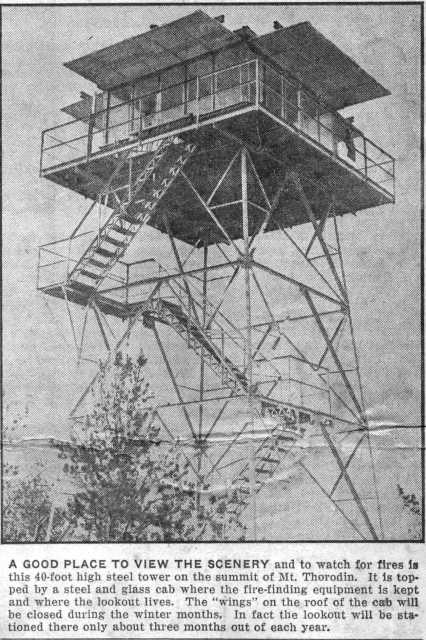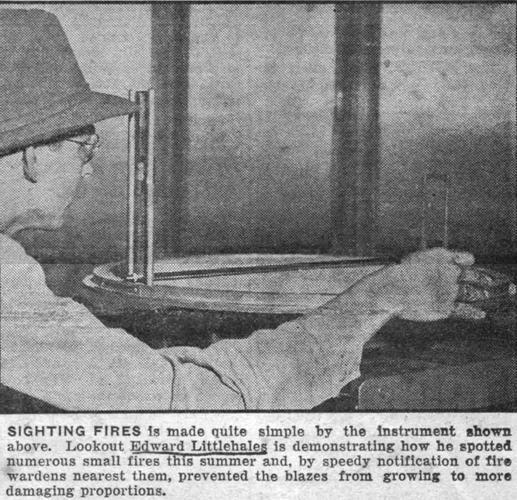Mount Thorodin Lookout
(Copied from clippings, courtesy of Ed Littlehales)
Boulder Daily Camera
Boulder, Colorado, Saturday September 13, 1941
Forest Service completes lookout atop Mt Thorodin
By John Buchanan
 Preventing fires is the principal hope and aim of the forest service, but checking fires that do get started by lightning, by sparks from locomotive engines or carelessness on the part of persons riding or hiking in the mountains is one of the most important functions.
Preventing fires is the principal hope and aim of the forest service, but checking fires that do get started by lightning, by sparks from locomotive engines or carelessness on the part of persons riding or hiking in the mountains is one of the most important functions.
And in checking fires, speed is a prerequisite. Already speed in finding fires when they are small enough to check easily has been made possible by the new fire lookout tower on the summit of Thorodin, a 10,000 foot high peak south of Boulder and southwest of Pinecliffe.
The new lookout tower was completed last spring. The tower is steel framework 40' high. On the top of this is perched a steel and glass cab where the lookout lives for about three months out of the year - during the months when the fire danger is most high.
A High Peak
Mt Thorodin is the highest of the foothills peaks in this area. From it, a lookout can see "everything" - up beyond Estes Park to the north, down to Pikes Peak south, all of the continental divide between the two peaks to the west, and as far as the eye can see to the east.
There is a similar tower on Twin Sisters near Estes Park.
When a fire in this district is spotted by one of the lookouts, he telephones the district forest service office in the Boulder post office. Art Randall, district ranger, will then notify the other lookout.
By using an instrument called an alidade - which somewhat resembles a surveying instrument - each lookout obtains a reading. They notify the forest ranger of this reading and, plotting out straight lines on a map before him, the ranger can tell exactly where the fire is.
Ranger Notified
 The ranger then telephones the nearest fire warden. Several wardens are located in this region. The fire warden summons volunteer workers, goes to the nearest forest service toolbox (many of the red boxes are spotted throughout the region) and the fight is on.
The ranger then telephones the nearest fire warden. Several wardens are located in this region. The fire warden summons volunteer workers, goes to the nearest forest service toolbox (many of the red boxes are spotted throughout the region) and the fight is on.
A national forest district with only one lookout tower is something like a policeman with one leg. That is why forestry officials in this region lost sleep at night until the tower atop Mt Thorodin was completed.
Finished just this spring, the lookout there has played an important part in the spotting of many fires. At least three of these might have spread into alarming proportions, acording to Ranger Randall, if the lookout had not been there.
Lookout is Student
A number of large fires in the region - the Jenny Lind fire several years ago being the most recent - might never got the head start they did had the Thorodin lookout been built.
Living in the 14 square foot cab this summer was Edward Littlehales, from New York. Littlehales is a forestry student. Lookouts are appointed through the US civil service system.
Contruction of the tower started on August 15, 1940. A lot of work went on before that, however.
The three mile foot trail from the road to the top of the mountain was built by a forest service crew in 1935. The trail, until the last quarter of a mile, is about four feet wide and not very steep. It was constructed so that, in case of a fire, fire-fighting equipment could be dragged up the mountain on "sleds" with wooden runners drawn by horses.
There is a similar trail to the top of Sugarloaf mountain, west of Boulder. The forest service hopes to someday erect a lookout tower there also.
Telephone Line
No further work was done in the Thorodin area until a year ago this spring. In May, 1940, a crew of workers erected a tent camp at the east base of the mountain and began clearing a right of way for a telephone line up to the fire lookout tower.
The line, coming directly to Boulder and crossing several canals, is 11 miles long. The forest service strung its line for seven miles on poles placed by the Mountain States Telephone and Telegraph company. For four miles, however, the poles had to be placed.
It was a tough four miles - rough dense forest land and in ? slopes. Dynamite was used liberally in blasting out some of the obstacles.
....
The tower was not completed, however. Cold weather came on and, fearing that frigid winds, sleet and ice might cause a tragedy among workmen constructing the giant tower, forest officials called off the work until the spring.
Finished this Spring
The cab was built this spring. The forest service workers carried every piece of material necessary in building the lookout to the top of the peak themselves. By using an old wagon road the supplies were taken to within about a quarter mile of the top - but the last quarter mile is the steep part of the mountain.
Sacks of cement were taken to the top on wooden "stretchers". Men, harnessed in teams and using single trees like teams of horses, carried steel girders to the top.
Trail Steep
The trail to the top from where the wagon stopped is hardly more than a pile of rocks in places.
One of the most difficult jobs was getting a cook stove in the cabin. First there was the trek up the long mountain trail, then the final 40 foot ascent up the steel stairway.
Visitors are invited to climb the tower. There is no view comparable to the one visible from the tower any place in the Boulder region, unless it be from Sugarloaf Mountain.
The lookout will be closed soon but it will be possible to climb the stairway to the tower at all times.
One can drive to the base of the mountain by following the Coal Creek canon highway until a road to the south, leading to the Denver Bible Institute campgrounds, is reached. There are two junctions in this road. The motorist should take the one to the right at the first junction, then one at the left at the second.
Hikers are cautioned to watch for storm clouds. Because of the high altitude, in spite of the peak being in the foothills, snowstorms can be expected at any time.